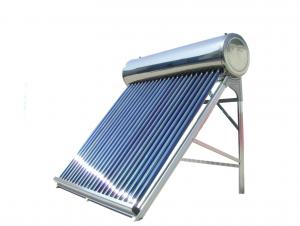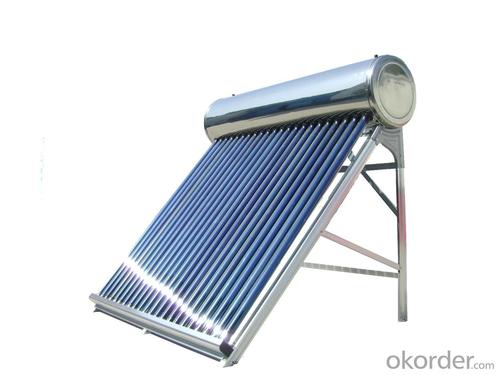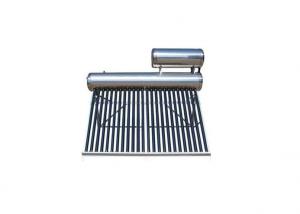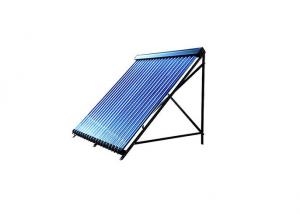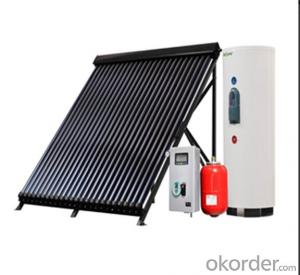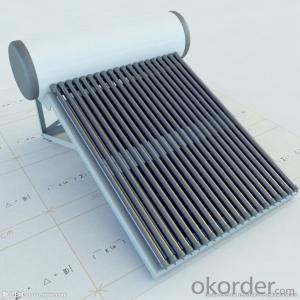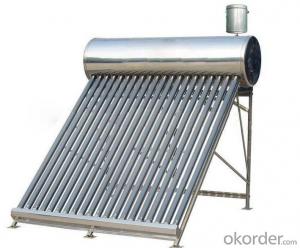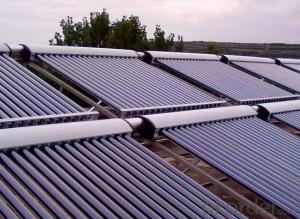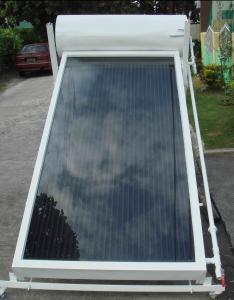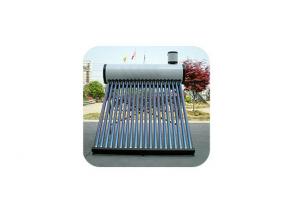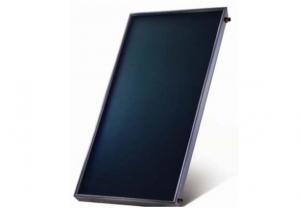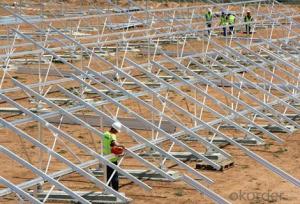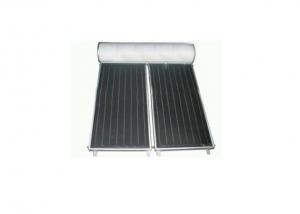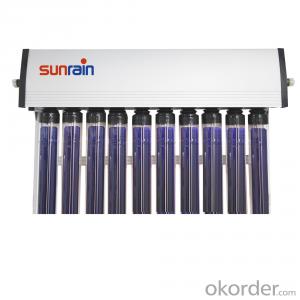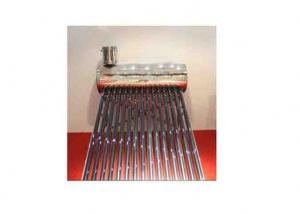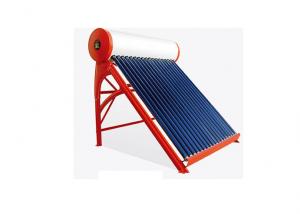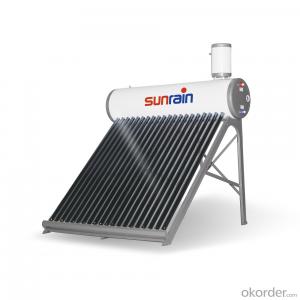Roof Solar Water Heater FS-PTZ Series
- Loading Port:
- SHENZHEN Port
- Payment Terms:
- 100%TT
- Min Order Qty:
- 1000Units unit
- Supply Capability:
- 1-10000/month unit/month
OKorder Service Pledge
OKorder Financial Service
You Might Also Like
Details Of Solar Flat Plate Collector
Specifications Of Solar Flat Plate Collector
MODEL | FS-PTZ Series |
Size of Frame(mm) | 2000×100×80 |
Size of Fin | φ0.45*141mm |
Aperture area | 2.0 m^2 |
heat absorption coating | anodic oxidation ;nickel plating |
Size of header pipe(mm) | φ22×0.6 |
Size of branch pipe(mm) | φ10×0.5 |
Frame Material | aluminum alloy |
Glass Cover | low iron ultrawhite;toughened glass |
Rated working pressure | 1.0MPa |
Carton Dimension | 2060*1040*100mm |
Weight(KG) | Solar Flat Plate Collector relies on warm water rising, a phenomenon known as natural convection, to circulate water through the evacuated glass tube collector and to the tank. Hot water storage tank is located above the absorber evacuated glass tubes. As water in the absorber heats, it becomes lighter and naturally rises into the tank above. Meanwhile, cooler water in the tank flows downwards into the absorber, thus causing circulation throughout the system38 |
Load | 110/20GP |
Advantage Of Solar Flat Plate Collector
1. It takes advantage of the tap water’s pressure. More pressure more comfortable.
2. The water is heated in short time and meeting your demand for hot water.
3. It can produce more hot water than the general types with continuous hot water coming.
Usage/Application Of Solar Flat Plate Collector
Integrated solar water heater,for independent courtyards such as villa, vacation village, rural housing and flat-roof buildings on the groundfloor. Split solar water heater.
Packaging & Delivery Of Solar Flat Plate Collector | |
Packaging Detai | Packaging Detail:Export Carton and Pallet or under customer request. |
Delivery Detail:10-20days | |

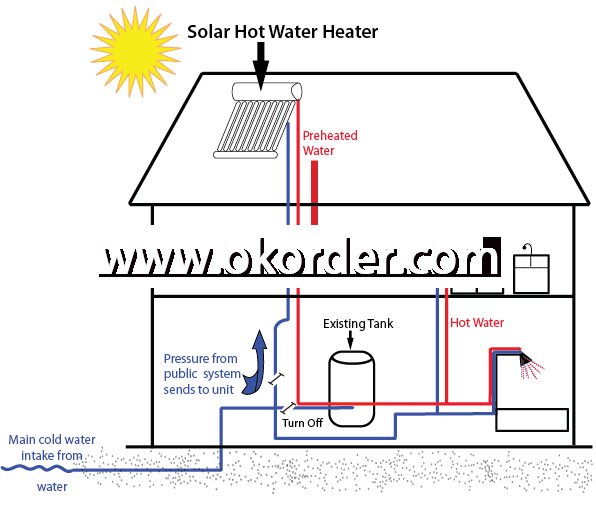
- Q: Can a solar water heater be used in apartment buildings or multi-unit dwellings?
- Yes, a solar water heater can be used in apartment buildings or multi-unit dwellings. In fact, it can be a highly beneficial and cost-effective option for such buildings. Solar water heaters use energy from the sun to heat water, reducing the reliance on traditional energy sources and lowering utility bills. In apartment buildings or multi-unit dwellings, solar water heaters can be installed on the roof or in a common area where they can harness sunlight efficiently. The heated water can then be distributed to individual units through a network of pipes. One of the advantages of using solar water heaters in apartment buildings is the potential for significant energy savings. By utilizing renewable energy, residents can reduce their carbon footprint and contribute to a more sustainable future. Additionally, solar water heaters have low operating costs since sunlight is free and abundant. Furthermore, using solar water heaters can help in meeting building codes and sustainability requirements. Many jurisdictions have regulations or incentives in place to encourage the use of renewable energy sources, making solar water heaters a viable option for apartment buildings. It is worth mentioning that the feasibility of installing a solar water heater in an apartment building may depend on various factors, such as the size of the building, available roof space, and local regulations. Additionally, the initial installation costs and maintenance requirements need to be considered. Overall, a solar water heater can certainly be used in apartment buildings or multi-unit dwellings, providing an eco-friendly and cost-effective solution for heating water.
- Q: Are there any compatibility issues with using a solar water heater with existing plumbing systems?
- Using a solar water heater with existing plumbing systems can sometimes lead to compatibility issues. However, these issues are usually minor and can be easily resolved. One potential problem is the mismatch in size and capacity between the solar water heater and the plumbing system. It is crucial to choose a solar water heater that aligns with the household's hot water needs. If the heater is too small, it may not be able to meet the demand, while if it is too large, it may cause pressure problems in the plumbing system. Another concern is the type of plumbing connections used in the existing system. Proper installation of a solar water heater requires specific fittings and connections. It is important to ensure that the existing plumbing system can accommodate these connections or make the necessary modifications for a proper fit. Furthermore, the location of the solar water heater can also create compatibility issues. Adequate sunlight is necessary for solar panels, so it is crucial to install them in a spot that receives enough sunlight throughout the day. If the existing plumbing system is in a shaded area, it may not be suitable for a solar water heater installation. In such cases, alternative locations or modifications to the plumbing system may be needed. Lastly, the age and condition of the existing plumbing system can affect compatibility. Older systems may have worn-out pipes and fittings that are not compatible with a solar water heater. In such situations, additional repairs or upgrades to the plumbing system may be necessary to ensure compatibility. In summary, while compatibility issues can arise when using a solar water heater with existing plumbing systems, they are typically not significant and can be resolved through careful planning, installation, and possible modifications to the plumbing system. It is advisable to consult with a professional plumber or solar water heater installer to assess compatibility and ensure a smooth integration.
- Q: What is the payback period for a solar water heater installation?
- The payback period for a solar water heater installation depends on various factors such as the upfront cost of the system, energy savings achieved, and local incentives or subsidies. On average, it can range from 3 to 7 years, but this can vary considerably depending on individual circumstances.
- Q: Can a solar water heater be used in apartments or multi-family buildings?
- Yes, solar water heaters can be used in apartments or multi-family buildings. They can be installed on the rooftop or any other suitable location where sunlight is available. Each unit or apartment can have its own solar water heater system, or a centralized system can be installed to provide hot water to multiple units. This can help reduce energy consumption and lower utility bills for all residents.
- Q: Can a solar water heater be used in areas with limited installation options?
- Yes, a solar water heater can be used in areas with limited installation options. Solar water heaters can be installed on rooftops, terraces, or even ground-mounted in open areas. They are flexible in terms of installation and can be adapted to fit various space constraints. Additionally, there are different types of solar water heaters available, such as integral collector-storage systems or thermosiphon systems, which may offer more installation options depending on the specific requirements of the area.
- Q: What is a solar water heater?
- A solar water heater is a device that uses the energy from the sun to heat water. It consists of solar collectors, which absorb sunlight and convert it into heat, and a storage tank to hold the heated water. This renewable energy solution is eco-friendly and can significantly reduce the need for conventional water heating methods, helping to lower energy costs and carbon emissions.
- Q: Open a solar water heater manufacturers need to have what conditions
- (30 yuan can help you retrieve 5 names, so many names repeat, common names do not try, avoid wasting the money) 2 rent: a special office to rent an office, if you own a factory or office can, in some places is not allowed in residential buildings in the office. Rental housing rental contracts to be signed, and the landlord to provide a copy of real estate license. Sign the rental contract, but also to the tax bureau to buy stamp tax, annual rental rate of 1/1000 of the purchase, such as your annual rent is 10 thousand yuan, tax 10 yuan would buy, attached to the rent contract home, followed by those who need to use the rent contract in place, need to copy the contract a post stamp tax.
- Q: Can a solar water heater be used in areas with limited access to building permits?
- Yes, a solar water heater can be used in areas with limited access to building permits. Solar water heaters are generally considered to be passive solar systems and may not require a building permit in some locations. However, it is important to check the local regulations and consult with local authorities to ensure compliance with any applicable restrictions or guidelines.
- Q: Can a solar water heater be used in areas with limited access to energy management systems?
- Yes, a solar water heater can be used in areas with limited access to energy management systems. Solar water heaters rely on sunlight to heat water, so as long as there is sufficient sunlight available, they can operate independently of energy management systems. They are a sustainable and cost-effective solution for providing hot water in areas with limited access to conventional energy sources.
- Q: Are there any noise-related issues with solar water heaters?
- No, solar water heaters do not produce any noise as they rely on passive processes to heat water, such as sunlight absorption and heat transfer through pipes.
1. Manufacturer Overview
| Location | Guangdong,China |
| Year Established | 1990 |
| Annual Output Value | Below US$1 Million |
| Main Markets | WORLDWIDE |
| Company Certifications |
2. Manufacturer Certificates
| a) Certification Name | |
| Range | |
| Reference | |
| Validity Period |
3. Manufacturer Capability
| a) Trade Capacity | |
| Nearest Port | GUANGDONG,SHENZHEN |
| Export Percentage | 61% - 70% |
| No.of Employees in Trade Department | more than 200 |
| Language Spoken: | English, Chinese |
| b) Factory Information | |
| Factory Size: | 500 square kilometre |
| No. of Production Lines | 2 |
| Contract Manufacturing | |
| Product Price Range | |
Send your message to us
Roof Solar Water Heater FS-PTZ Series
- Loading Port:
- SHENZHEN Port
- Payment Terms:
- 100%TT
- Min Order Qty:
- 1000Units unit
- Supply Capability:
- 1-10000/month unit/month
OKorder Service Pledge
OKorder Financial Service
Similar products
Hot products
Hot Searches
Related keywords
